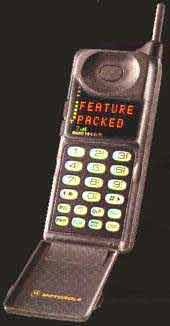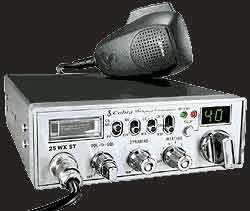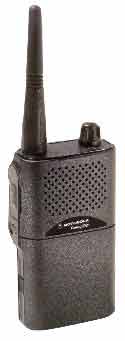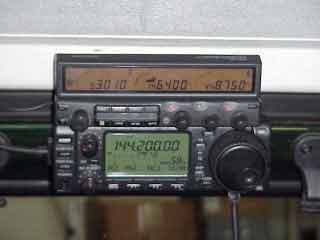This article was written by me and published on www.rockcrawler.com . It has since rolled off of the rockcrawler archives so I decided to post it on my website for other Jeepers to read.
Being able to communicate with other vehicles on the trail, or with someone back home, has never been easier. Today’s technology has given us the means to equip ourselves with a variety of radios that are both affordable and reliable. This article will highlight several of the more commonly available types and provide you with some helpful information, should you decide to inventory your “trail comm” equipment for a possible upgrade.
Even though trail communications can be unreliable at times, it is something you should strongly consider adding to your vehicle if you have not done so already. Note that the lack of reliability is not in construction or quality of the radio, but rather that all of them are dependent on factors that are sometimes outside of your direct control. Terrain, transmit power level, and ionospheric propagation (how the radio waves travel through the air) are just a few of the things that can influence your ability to successfully communicate with another person.

One of the more popular trail comm “take-alongs” is the ever-popular cellular phone. Anyone who has used one realizes that they will not work unless you are within the operating range of a cell site. Depending on your off-roading location, this may or may not be a problem. In my case, out in the middle of the Arizona nowhere, cell phone coverage is very spotty at best and usually nonexistent. Again, this will vary depending on where your favorite trails happen to be, and may even be dependent on your exact position on that trail. Cell phones are certainly useful and easy to operate, but usually are out of signal range. The price for a phone varies from free to several hundred dollars, depending on the model. Of course you must activate it and pay your monthly bill in order to use it, unless you purchase prepaid cell phones, where you pay upfront. The best part about a phone is that you can talk directly to whom you want, with no relaying of information by someone else.

The oldest and most popular method of trail communications has to be the CB radio. Its popularity boomed back in the ‘70s, owing much of its notoriety to the tractor-trailer movie era. Available at almost every discount department store, they provide adequate vehicle to vehicle coverage while on the trail. Using one to communicate 50 or more miles back to your home is often times impossible to do. It can be difficult to talk with someone even when the distance is significantly less. Part of the reason for this is that CB radios use the upper portion of the high frequency (HF) radio spectrum, around 27 MHz. A small portion of the CB radio signal travels along the ground (called ground wave) which is what is usually required for short-range communications of this type. Most of the transmitted signal radiates up and out into the ionosphere. If conditions are right, some of it will be reflected back down to earth, a thousand or more miles away from where it started while the remainder simply travels off towards some distant star. Experienced CB users refer to this ionospheric reflection as “skip”. When conditions like this exist and the band is “open”, it is almost impossible to hear the weaker ground wave signals since they buried in the mixing of all of the other signals that are “skipping in”.
Three positive aspects of a CB radio is the low price, popularity, and no requirement for an operator’s license. In many off-road clubs, a CB is mandatory if you plan on participating in a club-sponsored ride. The CB radio allows members to easily communicate with each over the short distances encountered while traveling on the trail. It is an ideal method by which one can update the group on trail conditions or for summoning assistance from another club member. The price for a good radio and reasonable antenna puts this setup well within the $100 range.

Another type of radio that has recently appeared on the market is the Family Radio System (FRS) type radio. FRS is for non-business communications and was designed for short-range distances between family members. FRS uses the UHF frequency range (~460 MHz) and very low power (.5 watts), so the effective range is limited to a couple of miles maximum. While this will rarely help you communicate between your vehicle and someone back home, it does provide excellent talk-around capability between vehicles on the trail. These radios use FM transmitters and receivers, which results in a better sounding audio signal when compared to the AM type CB radios. Unlike the CB radio, FRS does not suffer from the effects of “skip”. In addition to this, most FRS radios can transmit a special sub-audible tone in addition to your voice. If the person’s FRS radio that is receiving your broadcast is also configured to receive this tone, it will only allow the receiver to work when the tone is present. So, even if the radio channel you are using is busy with other users, you can basically turn a “party line” into a “private line” by using these sub-audible tones. This is usually not needed, unless you are in a heavily congested area and there are many people using FRS radios (perhaps a large campground at a national park or the Easter Jeep Safari).
Since most of the FRS radios come in a very compact walkie-talkie design, they are perfect for operating in your off-road vehicle. On top of this, they are great for taking along on those short hikes to the lake, top of the mountain, or down to the campground general store. It is so easy to stick one in your pocket and take it with you. They also work well for mountain bikers and other related sports where short-range communications are handy. Because of their low transmit power, battery life is pretty good and most have an optional DC power adapter cord that can use the 12V from your vehicle’s battery. Another plus is the built in antenna, which means you don’t need one mounted on your bumper, rear-quarter panel, or the spare tire carrier. That means one less thing to get caught on a tree limb and broken on the trail. Most of these radios offer a variety of optional add-ons and usually include an accessory jack for a boom-mic headset that provides for hands-free operation. FRS radios can be had for under $100 and go up into the $200+ range. No license is required to transmit on a FRS radio.
The FRS radios share some of the frequencies that are allocated to the GMRS (General Radio Mobile Service) radios, the big brother to FRS. GMRS radios allow slightly higher power levels and can use repeaters to extend their range (see the section below about ham radio repeater operation). You must obtain a FCC license before operating a GMRS radio, however there is no test required to acquire the license. The restrictions imposed on what can be communicated on GMRS radios are more stringent than on FRS. If you are considering GMRS, you should do some research on the topic to determine if it will meet your needs. You can get more information at http://www.fcc.gov/wtb/prs/genmbl.html . The price for GMRS radios vary quite a bit. Because these radios are usually marketed in the “commercial” section of a manufacturers catalog, they tend to be more expensive. Adequate ones start in the $300 range and go up from there. They are available in both the walkie-talkie and mobile radio versions.

The least common radio that is also ideal for off-road travel is amateur radio, or “ham radio” as it is often called. I have been a licensed amateur radio operator for 45 years and rely heavily on it while I am off-roading in Arizona. My vehicle has several radios that cover a variety of frequencies and bands. It is a rare day that I can not reach home on at least one of them. My wife and one of my children also have their license. If I need to get in touch with someone at home and they are not answering, I can always contact a fellow radio-club member to assist with a quick relay. A ring on the phone will either bring my wife to the radio, or it will result in a message on the answering machine and she can call me later when she gets in. Of course, this is all based on the fact that she is NOT holding down the shotgun seat in my TJ while I am on the trail.
Many of you might be wondering why you should take a test (yes, a FCC license is required to use ham radio and a written test is required) just so you can talk on a radio. Let me give you an example of the potential that ham radio provides. A good friend of mine recently completed a 30 day off-road/camping trip in Utah. His base camp was some 40 miles north of Moab, out in the middle of nowhere. Using his ham radio, he talked with his wife in Phoenix, Az. (she is also a licensed amateur operator) several times each day. He would relay to her his plans for the day, expected trails (she had a copy of them at home) he would be on, and even GPS coordinates when he deemed it necessary. (I am not advocating that you should make it a habit of off-roading alone. However, if you need to, amateur radio can certainly help fill the communications gap.) Oh, did I mention that he was able to reliably talk with his wife using only a 5 watt radio? For those of you who are wondering…no, he did not have to learn Morse Code. He is a member of a radio club that has a linked radio repeater system that spans no less than 6 states here in the Southwest. By using this linked system, he can be four-wheeling near Sacramento, Ca. and chat with me in Phoenix. The quality of the signal is like that of a regular phone conversation. You can find more information about ham radio at http://www.arrl.org .
Below are two of the radios that I have in my ’98 Wrangler. The top one is a Kenwood FM radio. The front panel is mounted above the rear view mirror, while the body of the radio is mounted under the driver’s seat. Most mobile ham radios have detachable front panels which makes them a breeze to mount in today’s dash-challenged vehicles.

The Kenwood covers three different ham bands and is primarily designed for use with radio repeaters. There are several linked repeater systems that cover my state to one degree or another. These linked repeater systems extend the range of your radio by relaying your signal from one repeater to the next, similar to the way a cell site works with your cell phone. By doing this, it provides the operator with a range of several hundred miles using only a 5 watt hand-held radio. If you use a 50 watt mobile radio with a good vehicle mounted antenna, the range will increase even further. The 36″ tall antenna for this radio is mounted on the right front fender of my Jeep.
The lower radio is the front panel of my Icom 706 radio. The remainder of the radio is located behind the drivers seat on the floor. This radio covers 3-30 MHz, 50-54 MHz, and 144-148 MHz. With it, you can literally talk around the world, around the country, around the state, or just around town. It will also work on repeater systems and offers the operator the use of FM, AM, CW, and SSB (single-sideband) modes of operation.
The main antenna for the Icom radio is an inexpensive 102″ stainless steel whip antenna that was donated to me from a CBer. The difference between this antenna and its use in the CB world is that in ham radio use, the antenna must be capable of operating over a very large frequency range. To accomplish this, the antenna is connected to a multi-band automatic antenna coupler that is attached to the right rear fender well in my Wrangler. The antenna coupler’s coax cable is connected to the radio and senses the frequency of the transmitted signal. When you change frequency on the radio, the antenna coupler automatically changes and matches the antenna to the correct frequency. By doing this, you are ensured of the best transmit signal possible. (This is the ham radio version of “tuning the antenna”.)
You may be wondering about the cost for ham radio? Well, the range is about as broad as is the selection. A good 50 watt mobile radio is priced around the $250 range, with used ones available for $100. The radio equipment in my TJ totals almost $3K. However, this represents a combination of two diverse hobbies all rolled into one.
One last comment on the communication topic; Please remember that none of these communication devices are worth carrying unless you have the proper power to operate them. If you carry a phone or portable radio, be sure to carry ample back-up power for it. Check the battery pack before leaving home and if possible, carry a spare battery. You can not completely rely on your vehicle’s battery for powering these devices. What happens if you develop an electrical problem in your vehicle?
I hope this article has given you a better perspective on Trail Communications. When making your decision on which “trail comm” tool is best for you, take a look at where you off-road and what it will take to summon help should the need arise. After all, the most basic use for off-road communications is to help ensure the safe return of you and your vehicle.
Enjoy the trails and please TREADLightly!
